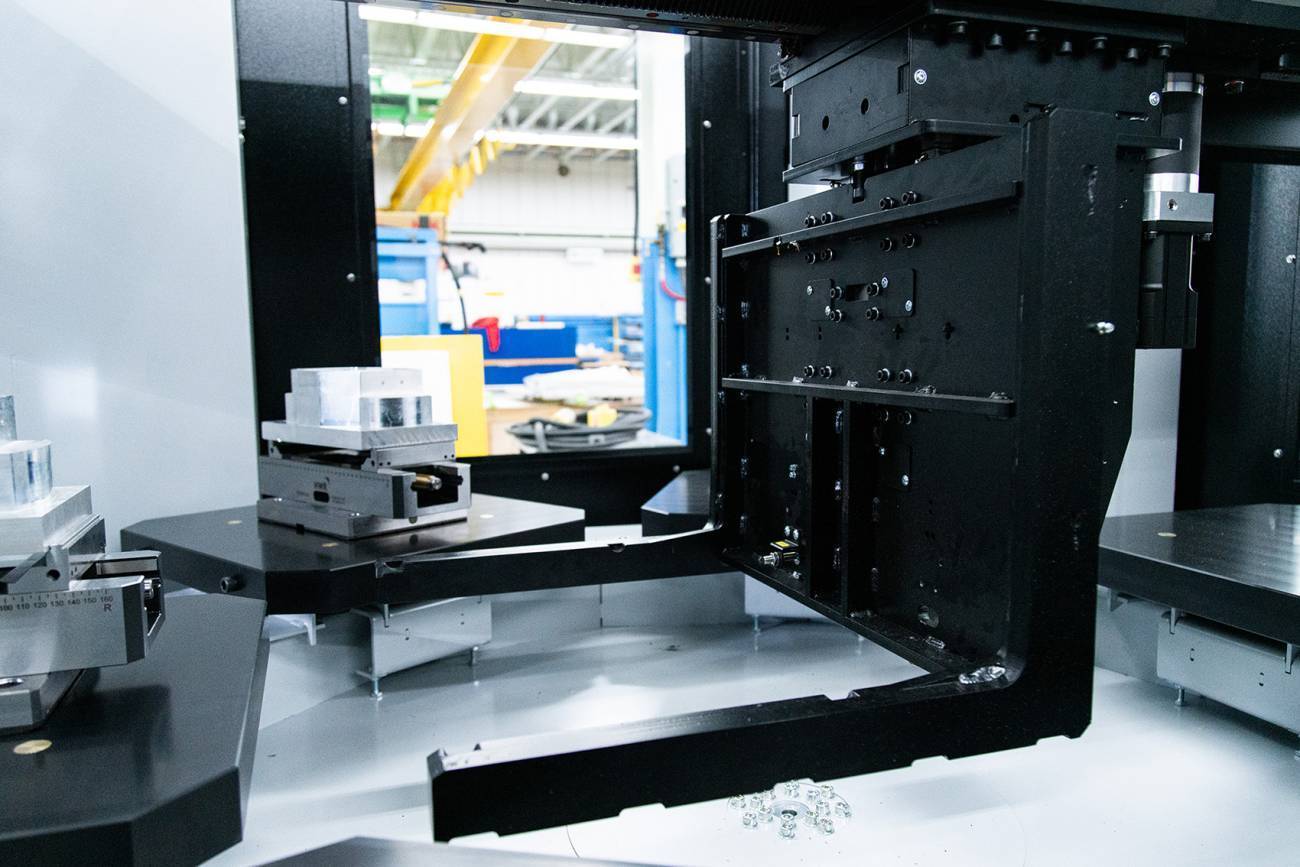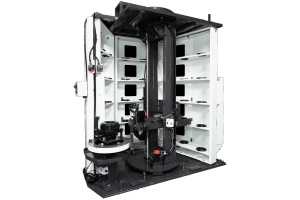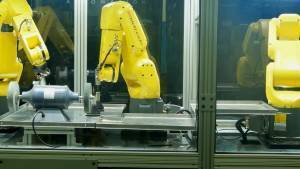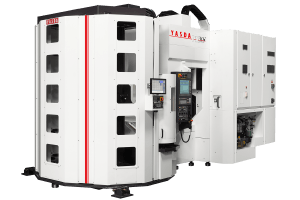The 4 Critical Steps 5-Axis Shops Should Take Before Implementing Automation

The Four Critical Steps Five-Axis Shops Should Take Before Implementing Automation
Automation isn’t a new concept. It wasn’t unearthed or created in a laboratory. Unless you manually crank a load of laundry through the wringer in the morning and saddle up to go to the bank with a deposit slip in hand so you can buy and then hand-grind your coffee, you’re benefitting from automation every day.
And realizing the advantages of automation is easy.
It only takes one button to start your laundry, one button to remotely start your car, another button to deposit a check, and a fourth to fill your coffee mug before you clock in for the day. Automation works because time is precious, and you don’t want to burn money paying someone to address straightforward tasks.
Apply the same concept to your five-axis CNC machine.
Five-axis machining minimizes the number of setups and manual intervention it takes to complete a component. However, this can also result in long cycle times, depending on the job and processes involved. There are several automation answers that can maximize your throughput. Integrating automation into your five-axis machine can allow you to run lights-out, increase your uptime, and get the greatest return on investment (ROI).
Maybe you’re overwhelmed by the complexity of an automation cell, or you’re not sure how to get started. Perhaps you can’t look past the dollar sign. Maybe you think you’re shop can’t gain anything from automation. Whatever the case, this article will show you the benefits of automation and how to get started integrating automation into your five-axis process.
1. Realizing the ROI
For some, the price tag that comes with automation can be a non-starter.
“I think some people think it’s harder than it is, and they mistakenly think it costs them money,” explains Thomas Saur, Vice President of FANUC America Products for Methods Machine Tools. “The return on investment is normally less than 18 months, sometimes less than a year.”
Adding automation to any machine will increase your uptime, throughput and allow you to run lights-out. Five-axis machines, in particular, are a substantial investment. And in manufacturing, every second a machine comes to a stop to change a part or a setup is a second that machine could be making chips.
Without automation on a machine, says Nick Giannotte, Director of Sales & Operations at Maruka USA’s Pine Brook, NJ technical center, users are essentially leaving money on the table.
“The higher the cost of a machine, the more important it is to the rate of return to run that machine as many hours, for as many days as possible,” Giannotte said.
He added that automation could lower operation costs for high-end machines and raise output to $250 per hour.
“At the end of the day, it’s just simple math,” Saur added. “It shouldn’t be hard to justify lights-out machining or any automation.”

Whether you’re adding an automatic pallet changer (APC), expanding your automatic tool changer (ATC), integrating a robot, or looking to design a custom cell, the outcome is the same: more uptime, and at the end of the day, more parts.
2. APCs, ATCs, and Robots
So you’ve determined to take your five-axis process to the next level with automation. Some manufacturers have long, drawn-out pro
cesses and may be seeking to streamline, while others could be looking to find new ways to increase throughput or add an unattended shift.
But where to start? It all depends on where you are trying to go and what your shop is capable of doing.
“We have to ask a lot of questions,” said Bernie Otto, Methods’ Director of Technical Support. “There are a lot of variables.”
High-mix/low-volume setups with longer cycle times might opt for an automatic pallet changer (APC) to process various parts without manual intervention, while a low-mix/high-volume shop would be more likely to integrate a robot to remove parts and insert stock into the machine.
“There are always exceptions to the rule, but generally, that’s where you start,” Otto said.
Those looking to add or expand their APC need to determine the right combination of pallets and tools. Otto explained that manufacturers could explore new setups or implement redundant tooling for longer runs of lights-out machining.
One crucial aspect is determining how much capacity your ATC needs from the start.
“The price difference between 60 and 120 tools isn’t that big,” Otto said. “The transition to handling more jobs later is much easier.”
Machines offered by KIWA Machinery Co. Ltd. and OKK Corp. have expandable ATCs. Otto said users often modify these models in the field to double their tool counts in as little as a day and a half.
“Once you have more tools, you generally don’t go back because you see the benefits of redundant tooling and different tooling,” Otto said.
On average, Methods expands 25% of machines with expandable APCs per year, Otto said, with half of those upgrading within a year.
Automation cells can open up a world of options for any business. Cells themselves can be paired with different machine configurations and setups to maximize floor space. Meanwhile, parts can be loaded/unloaded from carousels, vises, trays, rotary stockers, multi-drawer systems, in/outfeed conveyors, or other solutions.
 Methods’ Saur often gets many questions about end-of-arm tooling for robots. Partnering with a knowledgeable automation integration team is crucial, he said. In addition, many shops can manufacture end-of-arm tooling for custom jobs.
Methods’ Saur often gets many questions about end-of-arm tooling for robots. Partnering with a knowledgeable automation integration team is crucial, he said. In addition, many shops can manufacture end-of-arm tooling for custom jobs.
And, automation can work for any manufacturer, even one-shift shops.
“That thinking that ‘I need high-volume production’ is old-school thinking. You don’t need [high-volume production] for automation,” said Maruka’s Giannotte.
You just need the correct program and the correct cell. Just ask Matt Mayfield, the machine shop manager at Tempco Electric Heater Corp.
“We’re mostly small runs,” he told Methods during a customer testimonial in 2019. “My average run on my machine is five pieces.”
Their team added an automated cell to the shop’s Nakamura-Tome AS-200 in 2019. With the machine running lights-out a night, his team opens the shop to a stockpile of finished parts each morning.
“It makes it easier. It definitely cuts down a lot of movement of material,” Mayfield said.
3. Programming and Tools: No Assembly Required
u’ve crunched the numbers and reached out to an applications/engineering specialist about some automation systems that would integrate seamlessly into your shop. Anyone looking to enter into automation should work with their supplier to ensure you have the right programs and tools in place to get the most out of your new setup.
Fortunately, programming automation is much easier than programming a five-axis machine.
“It’s the simplest thing there is to program,” said James Cummings, General Manager of X-Cell Tool & Mold, Inc. “There is no big programming make a robot work.”
Cummings speaks from experience. His introduction to integrating automation was 20 years ago when he added robots to his shop’s electrical discharge machining (EDM) capabilities. At his current shop, X-Cell Mold, Cummings has two five-axis YASDA machines, with a third on the way. There are some critical things he’s learned through decades of integrating automation.
“You have to set your pallets up to what your shop is used to using,” Cumming said. “For instance, the robot has a 3R pallet, but you have to mount what tooling you use throughout the shop onto that pallet.”
4. Flawless Results
Cummings has seen some of the same misconceptions circulate shops for years, namely that automation would yield faulty products. While Cummings once held that same notion earlier in his career, seeing the results changed his mind.
“The systems that are out there now are pretty much flawless,” he said.
Automation removes the potential for errors caused by manual intervention. Moreover, it allows your machine to produce high-tolerance parts, from the first part to the 10,000th part.
“The automation never seems to break down at all,” Cummings continued.
X-Cell has been investing in new technology. Their third YASDA machine, a PX30i, combines extreme precision and easy automation thanks to an ATC with a capacity for 314 tools and an ACP that comes with 33 pallets.
And as a mold shop that primarily serves the medical industry, flawlessness is critical to meet high tolerances and delivery times. During the coronavirus’s onset in the U.S., X-Cell Mold was tasked to make four double-injection molds for a ventilator component, all within 10 weeks.
“Without the two YASDAs and the automation, it would have been impossible to do,” Cummings. “We were the only shop that was on time, and our tools ran right out of the mold.”
Key Takeaways
- Realizing the ROI – It’s easy to see automation’s fast return on investment. Five-axis machines are substantial investments, and automation can maximize your ROI by running the machine unattended, getting much more work done in less time.
- Determining What to Automate: Do your research, find an experienced automation integrator, and review your options. There is no one-size-fits-all solution, so partner with a company that can identify your capabilities and needs to give you the best solution possible.
You can automate nearly any aspect of your shop, no matter what market you serve or how big your operation. Cells and robots can be configured in various ways to maximize throughput and floor space. APCs can be easily integrated into any setup, while some brands, such as KIWA and OKK, allow ATCs to be expanded in the field.
- Automation is easy- Integration and programming are straightforward. Machine shops can manufacture custom end-of-arm tooling to fit their needs, and programming automation is simple.
- Seeing is Believing – Automation provides flawless components with high tolerances day in, day out, reducing human errors and costly manual intervention. Shops that implement automation grow with automation. Once you start to see the chips fly faster during off-hours and make more parts per day, you will realize automation’s benefits.